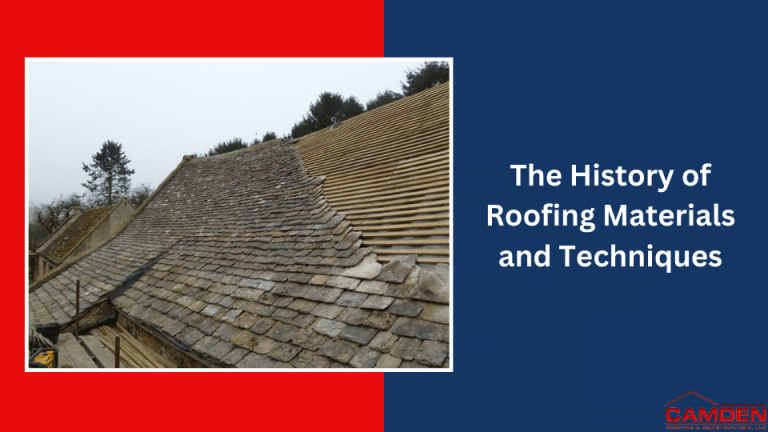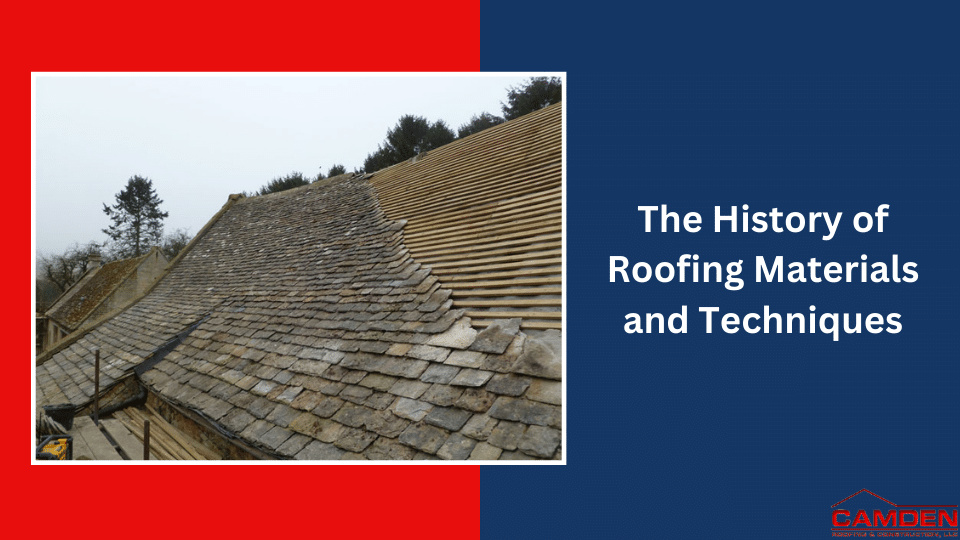The History of Roofing Materials and Techniques with Camden Roofing & Construction. The history of roofing materials and techniques is a fascinating journey through time, reflecting advancements in architecture, technology, and culture. From the earliest shelters to the modern roofing systems we use today, let’s explore the evolution of roofing materials and construction methods over centuries.

- Thatch Roofs (Prehistoric to Ancient Times):
The earliest roofing materials were natural and readily available. Prehistoric humans used materials like leaves, grass, and straw to create thatched roofs. These roofs provided rudimentary protection from the elements but required frequent maintenance and replacement.
- Clay Tiles (Ancient Civilizations):
Civilizations such as the Mesopotamians, Egyptians, and Greeks began using clay tiles for roofing around 10,000 BCE. Clay tiles were durable, fire-resistant, and provided better insulation than thatch. They are still used today in many parts of the world.
- Slate Roofs (Medieval Europe):
Slate roofs became popular in medieval Europe due to their durability and resistance to fire. The use of slate tiles allowed for more intricate roofing designs and added an element of beauty to Gothic and Tudor architecture.
- Thatched Roofs in Asia:
In parts of Asia, thatched roofs persisted as a common roofing material due to the abundance of bamboo and other natural resources. These roofs were often steeply pitched to shed rainwater effectively.
- Wooden Shingles (Colonial America):
Colonial America saw the widespread use of wooden shingles, primarily made from cedar or pine. Wooden shingles were readily available and provided decent insulation. However, they required regular maintenance to prevent rot and decay.
- Metal Roofing (18th Century):
Metal roofing gained popularity in the 18th century, with materials like copper, tin, and zinc being used. Metal roofs were valued for their longevity and ability to withstand harsh weather conditions.
- Asphalt Shingles (19th Century):
Asphalt shingles emerged in the 19th century, offering an affordable and durable roofing material. They quickly became a popular choice for residential roofing due to their ease of installation.
- Reinforced Concrete (Early 20th Century):
The development of reinforced concrete in the early 20th century revolutionized roofing. Concrete allowed for flat roof designs, which were commonly used in commercial and industrial buildings.
- Modern Roofing Materials (Mid-20th Century to Present):
The mid-20th century saw the introduction of innovative roofing materials such as fiberglass asphalt shingles, which offered improved durability and fire resistance. Additionally, rubber and plastic roofing materials became popular for low-slope roofs.
- Green Roofing (21st Century):
With growing environmental concerns, green roofing systems gained popularity in the 21st century. These roofs are covered with vegetation, providing insulation, reducing urban heat island effects, and promoting environmental sustainability.
- Solar Roofing (21st Century):
Advancements in solar technology led to the development of solar roofing systems. These roofs integrate photovoltaic cells into roofing materials, allowing homeowners to harness solar energy while maintaining a traditional roof appearance.
- High-Tech Roofing (Present):
Modern roofing materials continue to evolve, incorporating advanced technologies such as cool roofing, which reflects sunlight and heat, and self-healing materials that can repair minor damage over time.
- Roofing Techniques:
Throughout history, various roofing techniques have emerged to meet the specific needs of different regions and architectural styles. These techniques include thatching, tiling, shingling, and the use of various adhesives and fasteners.
Conclusion:
The history of roofing materials and techniques is a testament to human ingenuity and adaptability. From humble thatched roofs to the high-tech roofing systems of today, roofing has evolved to provide shelter, protection, and energy efficiency. As we move into the future, we can expect further innovations in roofing materials and techniques that enhance sustainability, energy efficiency, and durability while preserving the beauty and functionality of our built environment.
For more information, contact Camden Roofing & Construction, LLC in Charlotte and Raleigh, NC, at 919-729-5050.

